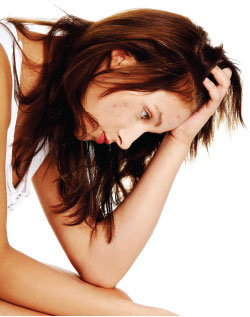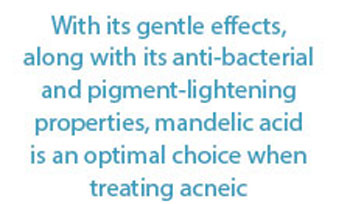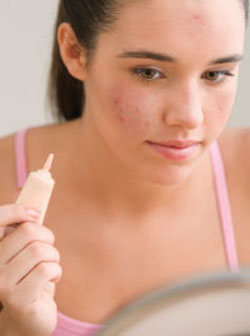When working with teenage skin, there are various factors to consider. The biggest concern with teenagers is acne. With the approach of puberty, most teenagers become self-conscience of their appearance, and the onset of acne comes with changing hormone levels. As a skin care professional, you should approach your teenage client with sensitivity towards their concerns.
Often times, parents of teenagers are searching for help and are frustrated and confused as to what treatment works best. When working with minors, it is most professional to consult with parents and make them aware of what choices they have. To avoid liability, the skin care professional should never work on a minor without the parent or guardian’s consent.
During the consultation, a complete health history should be completed and updated with each consecutive treatment. The skin care professional should make note of any previous or current dermatological therapy, including any oral or topical medications. Certain medications can affect clinical outcomes and can cause contraindications with some forms of therapy. If unsure, it is best to have the parent consult with a physician prior to any treatment.
 INTERNAL FACTORS
INTERNAL FACTORS
When treating acne, the skin care professional should consider multiple factors such as heredity, digestive health, immune health and hormones, as well as lifestyle factors such as diet, cosmetics, inflammation, and stress. Addressing internal factors are just as important to consider as the external condition of the skin.
Internally, a sluggish digestive system may be pointed as the real cause of many skin disorders and skin diseases such as acne. The nourishment of the body and overall health relies on the good reduction of food elements in the digestive tract into useful components. Failure of the digestive system to do this may result in the fermentation of body toxins, which may give rise to acneic conditions. A sluggish digestive system may be due to lack of hydrochloric acid, which is essential in digestive processes. Studies have shown that several diseases, such as acne, are associated with hydrochloric acid depletion. Contributing factors to hydrochloric acid depletion include long-term use of antibiotics as well as caffeine intake. Long-term use of antibiotics can also contribute to a biotin deficiency, which can cause acneic conditions.
The Immune System
With acne, the impairment of the immune system should be considered as well. The skin is the largest organ in the body and it provides the outlet for internal toxicity and chemical imbalances in body tissues and organs. Clinical studies have shown that vitamin A and vitamin D deficiencies as well as vitamin B2, B3, B5, and B6 deficiencies can contribute to acneic conditions. Nutrient deficiencies in zinc and selenium should also be considered. Since zinc plasma levels depend on vitamins A and D, both vitamins should be included with zinc supplements when treating zinc deficiency. Vitamin supplements such as a B50 vitamin, includes vitamin B12 as well as other B vitamins, which will strengthen the immune system, and regulate the function of the sebaceous glands.
Inflammation
Internally, inflammatory contributors should be considered when treating acne. Studies have shown that there is a connection between sugar and inflammation in the body. When there is a rapid rise in blood sugar, there is an insulin response. The insulin response then causes an inflammatory response. A rapid rise in blood sugar can cause inflammation throughout the body and may contribute to inflamed skin conditions. The stimulation of the oil glands brought on by pro-inflammatory responses can result in clogged pores and an increase in pro-inflammatory fatty acids. These fatty acids release the chemical messengers known as cytokines, thus stimulating more inflammation. Nutritionally, vitamins such as B6 will help maintain blood glucose levels within a normal range, and vitamin B5 will help reduce inflammatory responses. Anti-inflammatory therapy can include antibiotics, azelaic acid, mandelic acid, polyhydroxy acids, as well as a low glycemic diet and a diet that eliminates white wheat.
Stress
With the onset of adolescence, hormones and stress have a direct impact on the activity of the sebaceous glands. Systemically, stress stimulates hormone levels which directly affect the rate enzymes synthesize lipids. The hair follicle lining’s function is influenced by androgens, which are hormones produced by the adrenal glands. Female teenagers are most affected by pro-inflammatory responses related to cortisol and insulin and the effects of androgens in the body. Female androgens are synthesized in the adrenal glands, and are therefore more susceptible to adrenal hormone stimulation and inflammation. With females, elevated hormone levels prior to menstruation can increase acne breakouts. Excessive androgen production in both males and females can worsen acneic conditions in teenagers as well as adults. Anti-androgen drugs can be used to reduce excessive oil and sebum production, but there are side effects associated with these drugs. Nutritionally, vitamin B5 will help reduce stress responses, and is needed for proper function of the adrenal glands and balancing hormone levels. Clinical studies have shown that a vitamin B5 deficiency can contribute to acneic conditions, and should be considered prior to treating the teenage client.
 EXTERNAL FACTORS
EXTERNAL FACTORS
Externally, acneic conditions can arise from an over-production of oil produced from enlarged oil glands. Another important cause of acne is the buildup of skin cells that have not shed properly in the lining of the sebaceous follicle. When this happens, sebum can back up and become trapped causing normal skin bacteria to be trapped as well. Research has shown that when normal skin bacteria is trapped and there is an oil-releasing blockage that has developed from the sebaceous gland, harmful bacteria will multiply excessively within the hair follicle, and pustules or pimples will form. When left untreated, bacteria and oil will build up and become trapped within the follicle. This buildup can lead to more severe acneic conditions.
Exfoliating the sebaceous follicle will allow healthy bacteria to multiply and help reduce oil production. Products that contain salicylic acid or lipohydroxy acids are effective to exfoliate the sebaceous follicle and can help reduce the buildup of harmful bacteria. Professional treatments, such as salicylic acid peels, will help reduce acne lesions, including the Jessner peel, which works synergistically to combat acne and improve post-inflammatory scarring.
TREATMENT OPTIONS
Treatments such as photodynamic therapy, photopneumatic therapy, and specific laser energy that targets the sebaceous follicles such as the 1450nm diode laser, the 1314nm Nd:YAG laser, or the 1720nm laser, causes thermal injury to the sebaceous gland effectively reducing sebum production and treating acneic conditions.
When treating acne, controlling and reducing P. acne bacteria is necessary to improve acneic conditions. Topical applications may include benzoyl peroxide, antibiotics, mandelic acid, pyruvic acid, and blue light therapy, as well as holistic therapy such as probiotics, lactoferrin, and thyme. When treating acne, a topical anti-bacterial treatment is crucial, and should be included with a night skin care regimen.
 Probiotics are live cultures of healthy bacteria that exist on the skin. When treating acne, it is important to encourage healthy bacteria on the skin and balance natural microflora. Probiotics is a natural and effective way to reduce acne lesions and will encourage healthy bacteria, help boost immune health, and improve digestive health. Probiotic therapy can be topical or oral, and is an effective way to reduce P. acne bacteria in the skin. With acne, antibiotic therapy is commonly prescribed to control bacteria and reduce inflammation, and should not be combined with probiotic therapy. Antibiotic therapy is broad spectrum and will reduce the effectiveness of probiotic therapy.
Probiotics are live cultures of healthy bacteria that exist on the skin. When treating acne, it is important to encourage healthy bacteria on the skin and balance natural microflora. Probiotics is a natural and effective way to reduce acne lesions and will encourage healthy bacteria, help boost immune health, and improve digestive health. Probiotic therapy can be topical or oral, and is an effective way to reduce P. acne bacteria in the skin. With acne, antibiotic therapy is commonly prescribed to control bacteria and reduce inflammation, and should not be combined with probiotic therapy. Antibiotic therapy is broad spectrum and will reduce the effectiveness of probiotic therapy.
A very safe and effective treatment for acne is blue light therapy. In clinical comparisons, blue light therapy reduced inflammatory acne vulgaris lesions by an average of 34 percent, in comparison to 14 percent of patients using topical one percent clindamycin solution. For optimal benefit, clinical studies have shown that light application of 15 minutes twice a week is effective to reduce P. acnes bacteria. Studies have shown that exfoliation prior to light therapy is most effective and allows for optimal light penetration.
Clinical studies have shown that topical application of four percent niacinamide applied twice daily, helped control acne bacteria. When using niacinamide, the results were comparable to using the topical antibiotic clindamycin, but with no side effects. As a treatment option, niacinamide can be used in conjunction with antibiotics. With the powerful anti-bacterial properties of mandelic acid, a client may not have to resort to traditional topical antibiotics. Mandelic acid is gentle and less irritating compared to other topical acne treatments, and is an effective exfoliant to control oil and unclog pores. With mandelic acid, the client may experience some dryness and peeling, and ingredients such as hyaluronic acid, pantothenic acid, ceramides, lactomide, GHK copper peptides, or atelocollagen will assist the skin in the repair process. For more resistant conditions, mandelic acid could be used synergistically with antibiotics or probiotics to control acneic conditions. Optimally, mandelic acid has synergistic effects and will also help lighten post-inflammatory hyperpigmentation. With its gentle effects, along with its anti-bacterial and pigment-lightening properties, mandelic acid is an optimal choice when treating acneic skin conditions.
Another option when treating acne is azelaic acid, which has anti-bacterial and anti-inflammatory benefits. When using azelaic acid, it may take up to four weeks to see the full effects of the treatment and the client may experience excessive burning, dryness, or irritation. Assisting the skin in the repair process with topical ingredients will help strengthen the skin barrier and reduce dryness and irritation caused by azelaic acid therapy.
One of the most common and effective anti-microbial treatments is benzoyl peroxide, which works as a peeling agent increasing cellular turnover, clearing pores, and reducing bacterial count. Research suggests that strengths of five percent and 10 percent benzoyl peroxide are not necessarily more effective than 2.5 percent. Benzoyl peroxide can cause dryness and irritation, although skin tolerance occurs a week or so after use. With benzoyl peroxide therapy, it is best to use a moisturizer with humectant properties to help reduce transepidermal water loss and strengthen skin barrier function. Synergistic therapy may include salicylic acid and sulfur, as well as aloe vera or chamomile which will help reduce irritation caused by benzoyl peroxide therapy.
When treating the teenage client, there are many factors to consider and discuss, such as diet, lifestyle, and an effective skin care regimen. Improving acneic conditions will improve self-esteem and give the teenage client confidence during adolescence years.

Linda Gulla is founder of the International Institute for the Advancement of Aesthetic Medicine, and offers advanced training to professionals as an educator and adjunct instructor in CME and CE. Gulla shares her knowledge in medical aesthetics, giving presentations to professionals at the International Dermal Institute. She has authored and published resource manuals in medical aesthetics and shared her expertise in advanced aesthetics as an editorial reviewer with Milady. Gulla provides professionals with opportunities for career advancement with the convenience of self-study, offering the first online certification in medical aesthetics, which includes content that has been accredited by the ACCME. This email address is being protected from spambots. You need JavaScript enabled to view it.
Want to read more?
Subscribe to one of our monthly plans to continue reading this article.